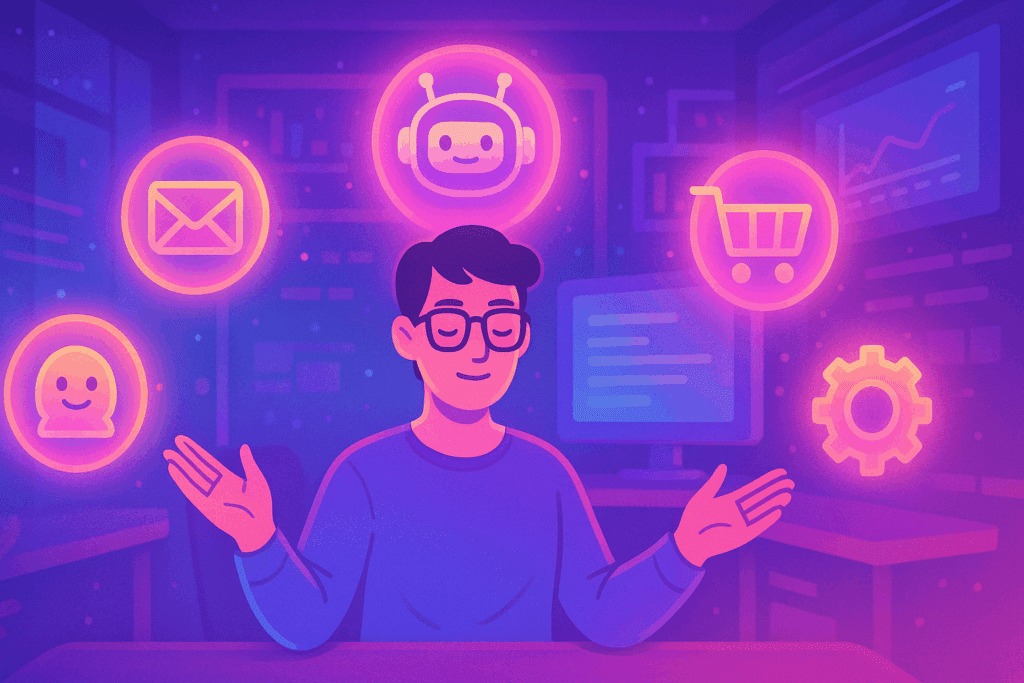Welcome to the Wild World of AI Agents
Okay, straight talk: “AI agents” sounds like some sci-fi nonsense, right? Like little digital spies sneaking around your data. But real talk? They’re nothing to be scared of. In fact, if you’re an SMB (small to medium-sized business) and you aren’t at least thinking about using AI agents… you’re already playing catch-up.
Let’s dig into what AI agents actually are — in plain English — and why you should care before your competitors beat you to the punch.
AI Agents Explained (Without the Geek Jargon)
First things first: an AI agent is basically a software program that can make decisions and act on its own — based on goals you set.
Think of it like hiring a really smart intern who:
- Doesn’t sleep.
- Doesn’t complain.
- Actually loves boring repetitive tasks.
Instead of just sitting there waiting for you to tell it every little thing (like traditional software), an AI agent can observe, plan, and act. It’s “orchestrated” to work with other tools, systems, or even other AI agents to get stuff done.
Pretty slick, right?
What AI Agents Can Actually Do for SMBs
If you’re thinking, “cool story, bro, but what does this mean for my business?” — buckle up.
1. Automate the Annoying Stuff
Scheduling meetings, sending follow-up emails, triaging customer service tickets, filing reports, updating CRM records… all that “busy work” that’s important but soul-sucking? AI agents eat that stuff for breakfast.
2. Personalize Customer Experiences
Imagine having a “concierge” for each customer, remembering their preferences, purchase history, and favorite cat meme. AI agents make this scalable. They can suggest products, send hyper-personalized offers, and keep customers feeling the love without you lifting a finger.
3. Improve Internal Efficiency
AI agents can:
- Predict inventory needs
- Flag performance issues
- Suggest workflow improvements
- Help new employees onboard faster
It’s like giving your whole team an extra set of super-smart hands.
4. Unlock New Revenue Streams
Here’s the spicy part: AI agents don’t just save time. They can help make money too. Predictive sales recommendations, upsell prompts, churn risk alerts — these little digital dynamos can find opportunities you might miss.
Agent Orchestration: The Next-Level Power Move
Alright, time to sprinkle a little buzzword magic: Agent orchestration.
Fancy name, simple idea. It just means getting multiple AI agents to work together like a symphony instead of a bunch of solo acts.
For example:
- One AI agent monitors your website traffic.
- Another notices a visitor lingering on a product page.
- A third sends a personalized offer while they’re still browsing.
All without human intervention.
Orchestration lets you scale AI impact without scaling complexity. You’re building a “digital team” that’s flexible, tireless, and ridiculously efficient.
Real-World Orchestration Workflows
Picture this: a small e-commerce store sets up AI agents to manage ads, handle abandoned cart emails, recommend products, and monitor shipping times. These agents “talk” to each other, handing off tasks at the perfect moment — like a relay race. The result? Higher conversions, lower overhead, and happier customers.
How Orchestration Platforms Work
Agent orchestration platforms are like a mission control center. They coordinate workflows, resolve conflicts between agents, and optimize task assignments on the fly. Tools like OpenAI’s “AutoGPT” or enterprise solutions like “Microsoft Copilot Studio” are making this orchestration easier than ever.
Best Practices for Orchestration
- Clear roles: Each agent should have a specific job.
- Constant monitoring: Check in on performance and adjust behaviors.
- Fail-safes: Always have fallback options if an agent hits a snag.
Why SMBs Need to Care About This (Like, Yesterday)
If you’re thinking “this sounds expensive” — relax. Modern AI solutions (including agent-based ones) are way more accessible than they were even two years ago.
And here’s the kicker:
Big companies are already leveraging AI agents to dominate. If SMBs don’t start using them, the gap will only get bigger.
The good news? Early adopters in the SMB space can:
- Serve customers faster and better
- Operate leaner
- Pivot smarter
- Create brand experiences that punch way above their weight class
Translation: You don’t just stay in the game. You start winning it.
Real-World Examples: AI Agents at Work
✨ Retail
AI agents monitor sales trends, predict stockouts, reorder inventory, and send VIP customers loyalty discounts.
✨ Professional Services
Agents pre-screen leads, book consultations, send prep materials, and even start onboarding new clients automatically.
✨ Healthcare
Appointment reminders, insurance claim follow-ups, patient education drip campaigns — AI agents handle the “between visit” chaos.
✨ Marketing
Content distribution, A/B testing, performance reporting… AI agents are already the secret weapon behind a lot of “overnight successes.”
But… Are There Risks?
Short answer: Yeah, but manageable ones.
- Bad inputs = bad outputs. Garbage in, garbage out. You need clear, strategic goals.
- Security matters. Protect sensitive data with appropriate measures.
- Over-automation is a trap. Don’t remove the human touch where it matters.
Basically, it’s not “set it and forget it.” It’s “set it, monitor it, and partner with it.”
Common Mistakes SMBs Make with AI Agents
1. Over-Automating Customer Service
Customers still crave human connection, especially when things go sideways. Relying entirely on chatbots without escalation paths can frustrate your best buyers.
2. Setting Vague Goals
“Make more sales” isn’t a clear enough mission for an AI agent. Specificity matters. Try “Increase upsells by 15% within three months” instead.
3. Ignoring Training and Maintenance
AI agents aren’t “fire and forget” tools. They need tweaking, training, and realignment as your business grows and market conditions change.
Avoid these rookie moves, and you’re already ahead of the game.
How To Get Started With AI Agents
Good news: You don’t need a PhD in computer science to get rolling.
Step 1: Audit Your Current Processes
Where are the repetitive tasks? Where could decision-making be faster or more personalized?
Step 2: Define Clear Goals
“More leads,” “faster onboarding,” “better customer service” — whatever matters most to your bottom line.
Step 3: Start Small
Pick one area. Pilot one AI agent. Monitor performance. Optimize before expanding.
Step 4: Orchestrate Over Time
As you build confidence, start layering AI agents into an orchestrated system.
Step 5: Partner with Experts
(Yeah, we’re gonna plug ourselves here. Shameless but helpful.)
AI strategy sessions with a team like Adroit can help you:
- Spot quick wins
- Avoid common pitfalls
- Build a roadmap for AI adoption that actually fits your business
Schedule an AI Strategy Session and let’s make some magic happen.
Case Study: How “ACME Retail Co.” Crushed It with AI Agents
Background: ACME Retail Co., a growing online boutique, struggled with abandoned carts, manual order fulfillment processes, and customer churn.
Solution: They introduced three AI agents:
- One monitored abandoned carts and sent customized recovery emails.
- Another agent tracked inventory in real-time and preemptively reordered hot-selling products.
- A third agent flagged high-risk customers (those about to churn) and offered them special discounts.
Results:
- Cart recovery rates increased by 35%.
- Inventory stockouts dropped by 50%.
- Customer retention improved by 20%.
Conclusion: With a modest investment, ACME scaled efficiency, grew profits, and reclaimed hours of manual labor every week. They now plan to roll out AI agents to manage social media engagement next.
Future Trends in AI Agents
- Autonomous Organizations: In the near future, SMBs may have “digital divisions” where AI agents independently handle customer service, sales, and marketing under human oversight.
- Multi-Agent Ecosystems: Expect to see groups of AI agents collaborating across businesses, like supply chain management where your supplier’s AI “talks” directly to yours.
- AI + IoT Integration: AI agents controlling not just software but physical devices — think smart warehouses, AI-managed offices, or automated manufacturing plants.
Bottom line: The AI agent revolution is just getting started, and SMBs have the chance to lead, not lag.
Final Thoughts: The Future Is (Agent) Active
AI agents aren’t the future.
They’re the right-now.
And SMBs that jump in early are going to be the ones still standing when the dust settles. It’s not about replacing humans. It’s about freeing humans to do more meaningful, creative, and impactful work — while your “digital team” keeps the lights on, the gears turning, and the customers smiling.
Ready to build yours?


